Dia Azzawi (Iraq, born 1939)Summer Nights oil on canvas, framed signed "Dia Azzawi" and dated "1968" in Arabic (lower right), further inscribed "Summer Night, Dia Azzawi, 1968, Iraq" on the verso, executed in 1968 100 x 80.7cm (39 3/8 x 31 3/4in).FootnotesProvenance: Property from a private collection, London Acquired directly from the Artist by the above Exhibited: Exhibition of Paintings by Dhia Al Azzawi, The National Gallery of Modern Art, Baghdad, 1968 Gallery One, Dia Azzawi, Beirut, 1968 Published: Exhibition Catalogue, Exhibition of Paintings by Dhia Al Azzawi, The National Gallery of Modern Art, Baghdad, 1968 Exhibition Catalogue, Gallery One, Dia Azzawi, Beirut, 1969 "Stylistically, Azzawi's work of the 1960s remained more figurative with stronger ties to mythology and history, which was the thread that maintained his connection to the Baghdad Group of Modern Art as their anticipated inheritor who could further their goals. Equally, Azzawi's use of colour reflected the inspiration of his teacher Faeq Hassan. He was thus able to negotiate two distinct strands of development in modern Iraqi art: the philosophical abstractions of Iraqi Signs and symbols by the Baghdad Group of Modern Art and Faeq Hassan's mastery of technique." - Saleem Al-Bahloly Compositionally, "Summer Nights" is perhaps archetypal of the artistic milieu that Dia Azzawi was operating in during the mid to late 1960's, the work flawlessly expresses the aesthetic and conceptual agenda of the "Baghdad Group of Modern Art" which was founded by Jewad Selim and Shakir Hassan Al-Said. The Baghdad group was defined by an attempt to reconcile the grand visual legacy of the past within the contemporary cultural and nationalistic narrative of 20th century Iraq. Mixing traditional Iraqi and Islamic motifs with a modernist visual language, Azzawi weaves a form of "folk modernism" which is both vernacular and universal. Focusing on recognisable ancient and local symbols, Azzawi's composition is stylised and simplified, almost creating an artistic caricature of Iraqi culture. Formative paintings within Azzawi's body of work, these would set the tone for his later contributions to the progress of Iraqi Modernism. Painted while the artist was still in his 20's, the works are stylistically sophisticated examples of a burgeoning modernist movement in Iraq. In the present works the artist abstracts cultural iconography mixing Islamic and pre-Islamic motifs found in ancient rock reliefs, Islamic manuscripts, metalwork and creates a rich tapestry of varied meaning as a result. In "Summer Nights", heavily stylized figures with rounded faces and bulbous eyes reminiscent of ancient Mesopotamian totems recline in bed sympathetically in a scene reminiscent of the enchanting tales of the 1001 Nights. Azzawi's abiding love and respect for the tonal characteristics of the natural world and for ancient Iraqi imagery shines through in this important early work, which echoes the formal approach and inimitable style of the 'New Vision' school of painting he would come to found in 1969. Azzawi typically incorporates structures and visual symbolism harking back millennia in his paintings, which is evident here in the pseudo-figurative form depicted in the composition, which recalls ancient Mesopotamian bass-reliefs and their mythological imagery. Azzawi started his artistic career in 1964, after graduating from the Institute of Fine Arts in Baghdad and completing a degree in archaeology from Baghdad University in 1962. His studies of ancient civilizations and Iraqi heritage had a profound impact on his art, and a key objective in the early formation of his artistic style was to link the visual culture of the past to the present. In 1969, Azzawi formed the New Vision Group (al-Ru'yya al-Jadidah), uniting fellow artists ideologically and culturally as opposed to stylistically. The group's manifesto, Towards a New Vision, highlighted an association between art and revolution, and sought to
Dia Azzawi (Iraq, born 1939)Summer Nights oil on canvas, framed signed "Dia Azzawi" and dated "1968" in Arabic (lower right), further inscribed "Summer Night, Dia Azzawi, 1968, Iraq" on the verso, executed in 1968 100 x 80.7cm (39 3/8 x 31 3/4in).FootnotesProvenance: Property from a private collection, London Acquired directly from the Artist by the above Exhibited: Exhibition of Paintings by Dhia Al Azzawi, The National Gallery of Modern Art, Baghdad, 1968 Gallery One, Dia Azzawi, Beirut, 1968 Published: Exhibition Catalogue, Exhibition of Paintings by Dhia Al Azzawi, The National Gallery of Modern Art, Baghdad, 1968 Exhibition Catalogue, Gallery One, Dia Azzawi, Beirut, 1969 "Stylistically, Azzawi's work of the 1960s remained more figurative with stronger ties to mythology and history, which was the thread that maintained his connection to the Baghdad Group of Modern Art as their anticipated inheritor who could further their goals. Equally, Azzawi's use of colour reflected the inspiration of his teacher Faeq Hassan. He was thus able to negotiate two distinct strands of development in modern Iraqi art: the philosophical abstractions of Iraqi Signs and symbols by the Baghdad Group of Modern Art and Faeq Hassan's mastery of technique." - Saleem Al-Bahloly Compositionally, "Summer Nights" is perhaps archetypal of the artistic milieu that Dia Azzawi was operating in during the mid to late 1960's, the work flawlessly expresses the aesthetic and conceptual agenda of the "Baghdad Group of Modern Art" which was founded by Jewad Selim and Shakir Hassan Al-Said. The Baghdad group was defined by an attempt to reconcile the grand visual legacy of the past within the contemporary cultural and nationalistic narrative of 20th century Iraq. Mixing traditional Iraqi and Islamic motifs with a modernist visual language, Azzawi weaves a form of "folk modernism" which is both vernacular and universal. Focusing on recognisable ancient and local symbols, Azzawi's composition is stylised and simplified, almost creating an artistic caricature of Iraqi culture. Formative paintings within Azzawi's body of work, these would set the tone for his later contributions to the progress of Iraqi Modernism. Painted while the artist was still in his 20's, the works are stylistically sophisticated examples of a burgeoning modernist movement in Iraq. In the present works the artist abstracts cultural iconography mixing Islamic and pre-Islamic motifs found in ancient rock reliefs, Islamic manuscripts, metalwork and creates a rich tapestry of varied meaning as a result. In "Summer Nights", heavily stylized figures with rounded faces and bulbous eyes reminiscent of ancient Mesopotamian totems recline in bed sympathetically in a scene reminiscent of the enchanting tales of the 1001 Nights. Azzawi's abiding love and respect for the tonal characteristics of the natural world and for ancient Iraqi imagery shines through in this important early work, which echoes the formal approach and inimitable style of the 'New Vision' school of painting he would come to found in 1969. Azzawi typically incorporates structures and visual symbolism harking back millennia in his paintings, which is evident here in the pseudo-figurative form depicted in the composition, which recalls ancient Mesopotamian bass-reliefs and their mythological imagery. Azzawi started his artistic career in 1964, after graduating from the Institute of Fine Arts in Baghdad and completing a degree in archaeology from Baghdad University in 1962. His studies of ancient civilizations and Iraqi heritage had a profound impact on his art, and a key objective in the early formation of his artistic style was to link the visual culture of the past to the present. In 1969, Azzawi formed the New Vision Group (al-Ru'yya al-Jadidah), uniting fellow artists ideologically and culturally as opposed to stylistically. The group's manifesto, Towards a New Vision, highlighted an association between art and revolution, and sought to
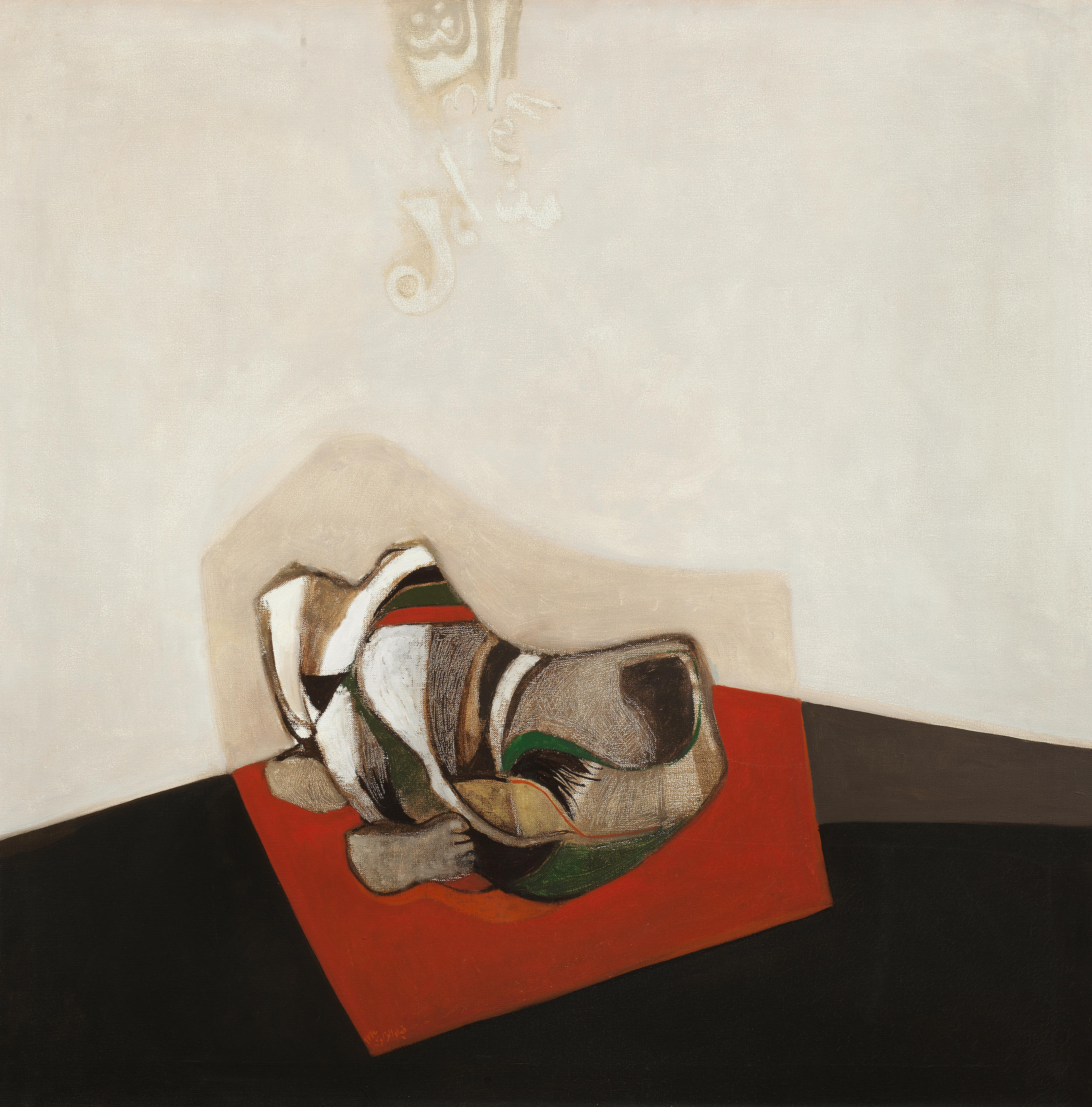



.jpg)

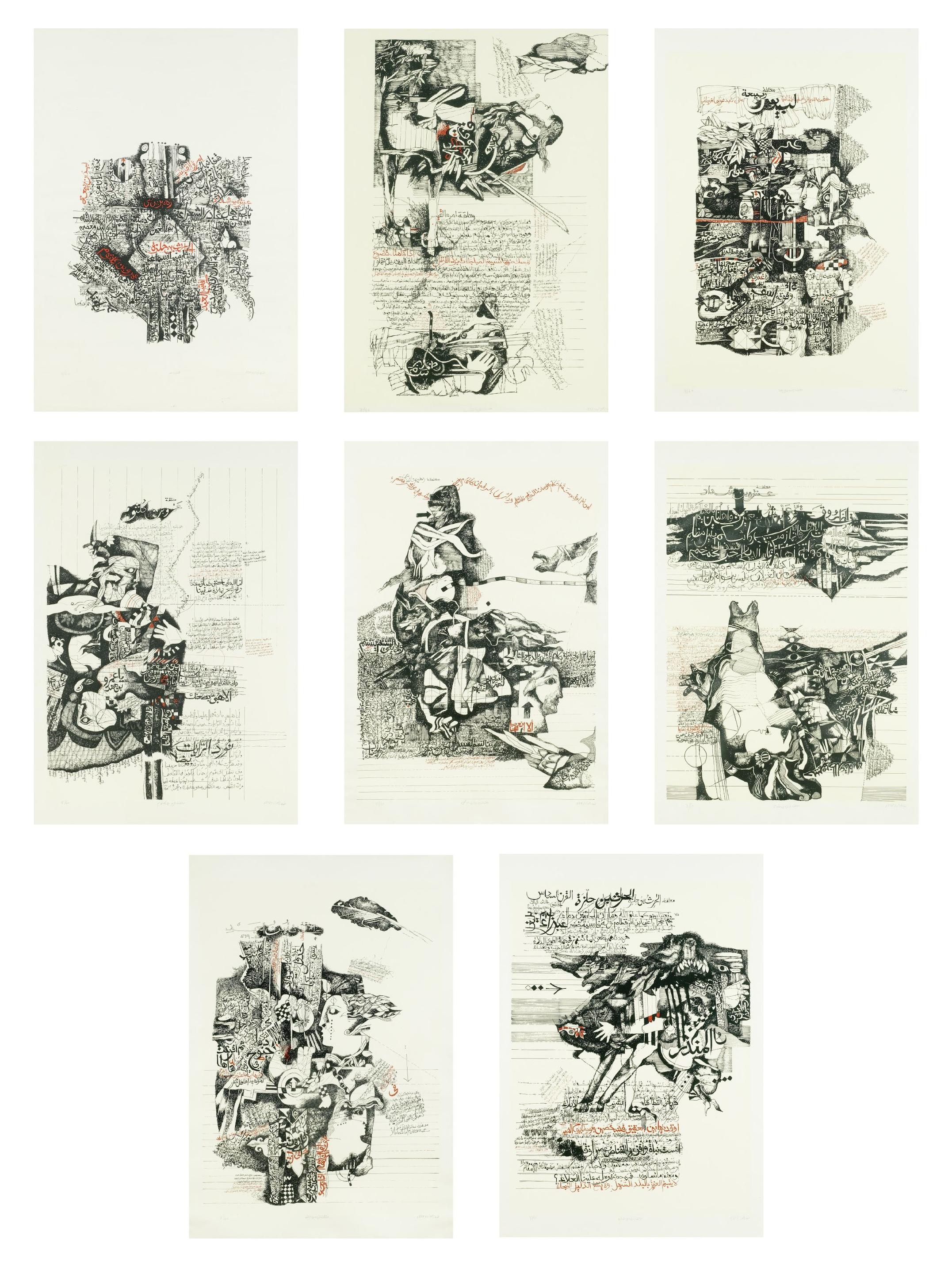
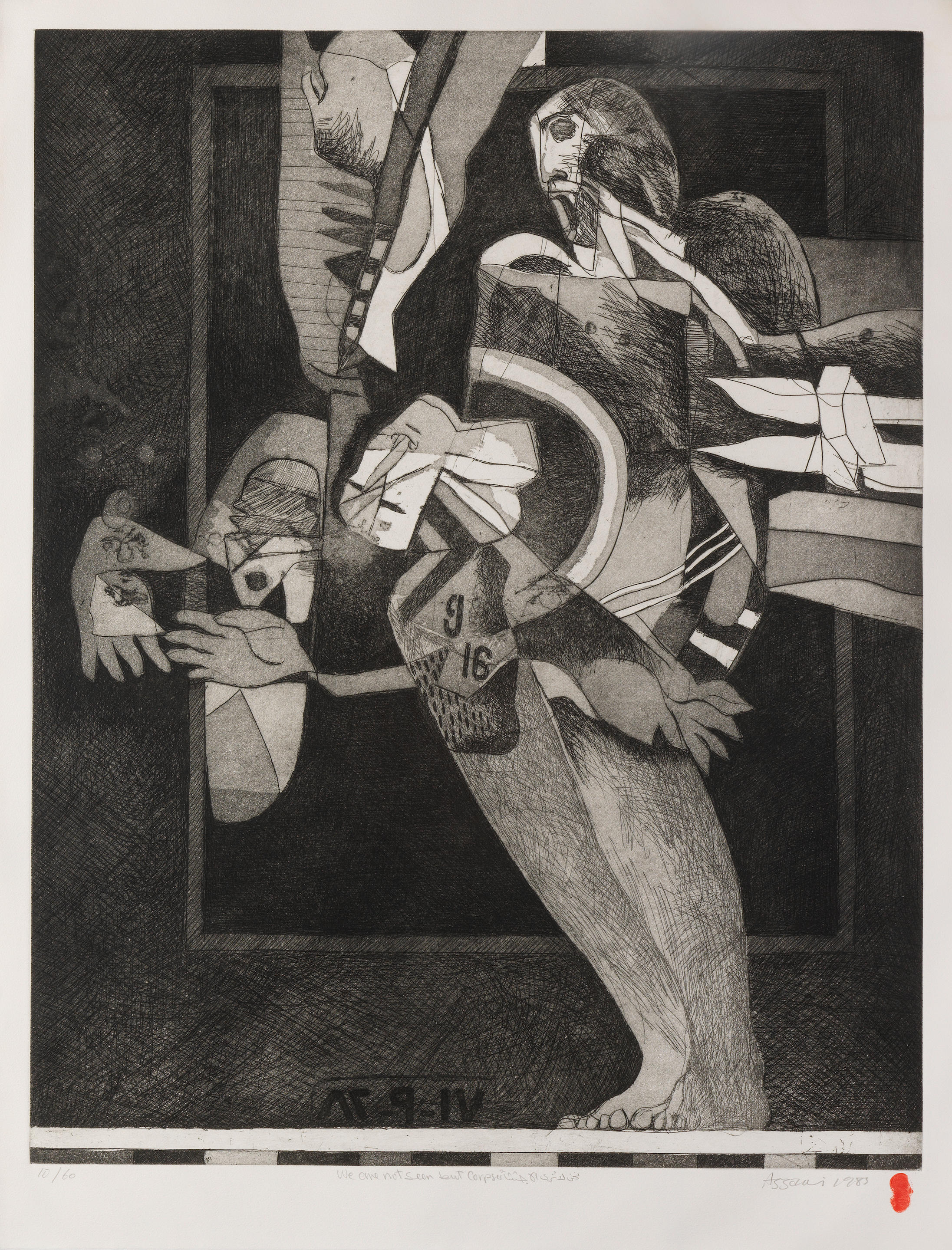
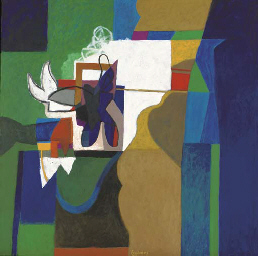

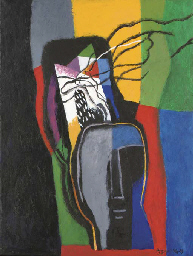
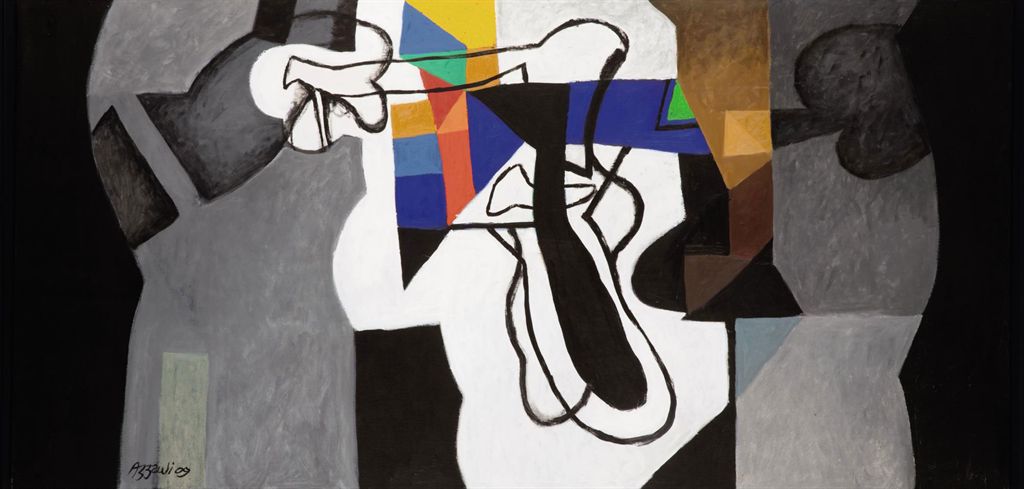
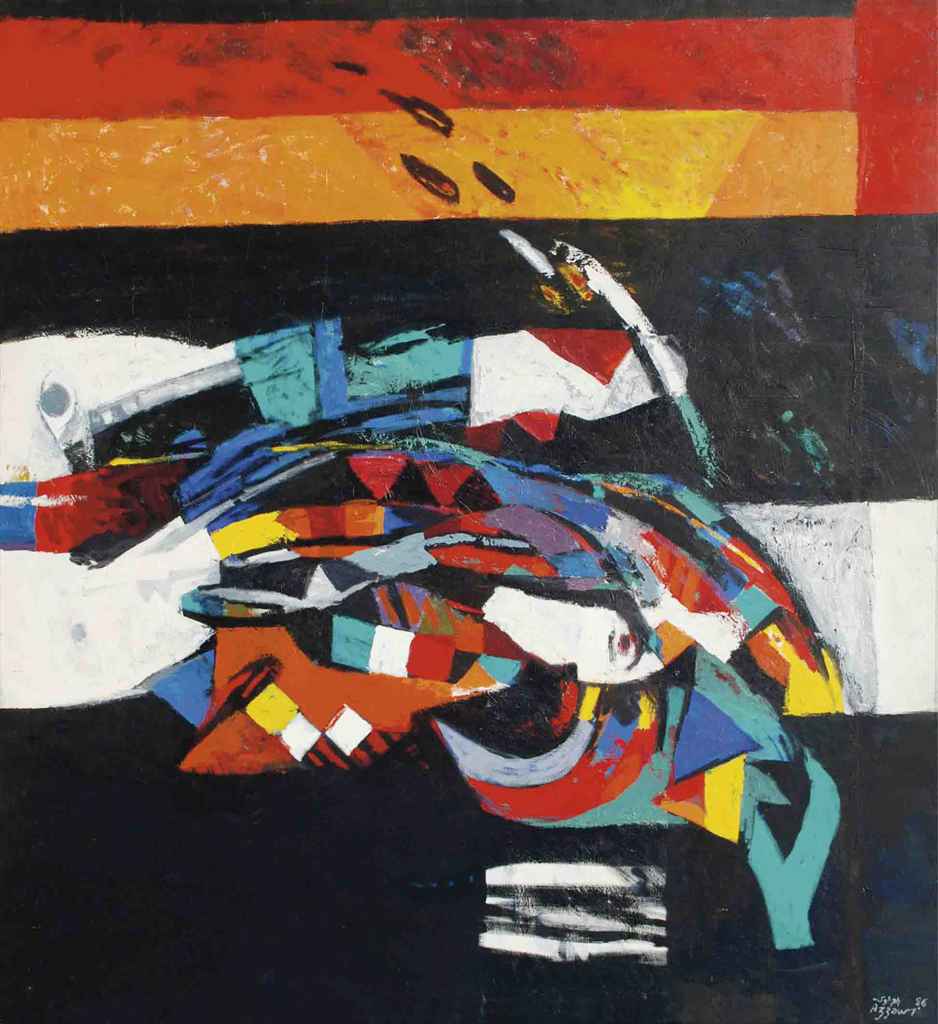
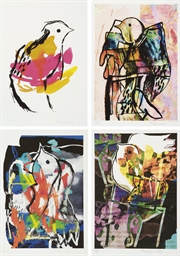
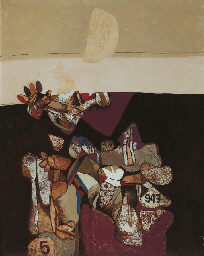
Testen Sie LotSearch und seine Premium-Features 7 Tage - ohne Kosten!
Lassen Sie sich automatisch über neue Objekte in kommenden Auktionen benachrichtigen.
Suchauftrag anlegen